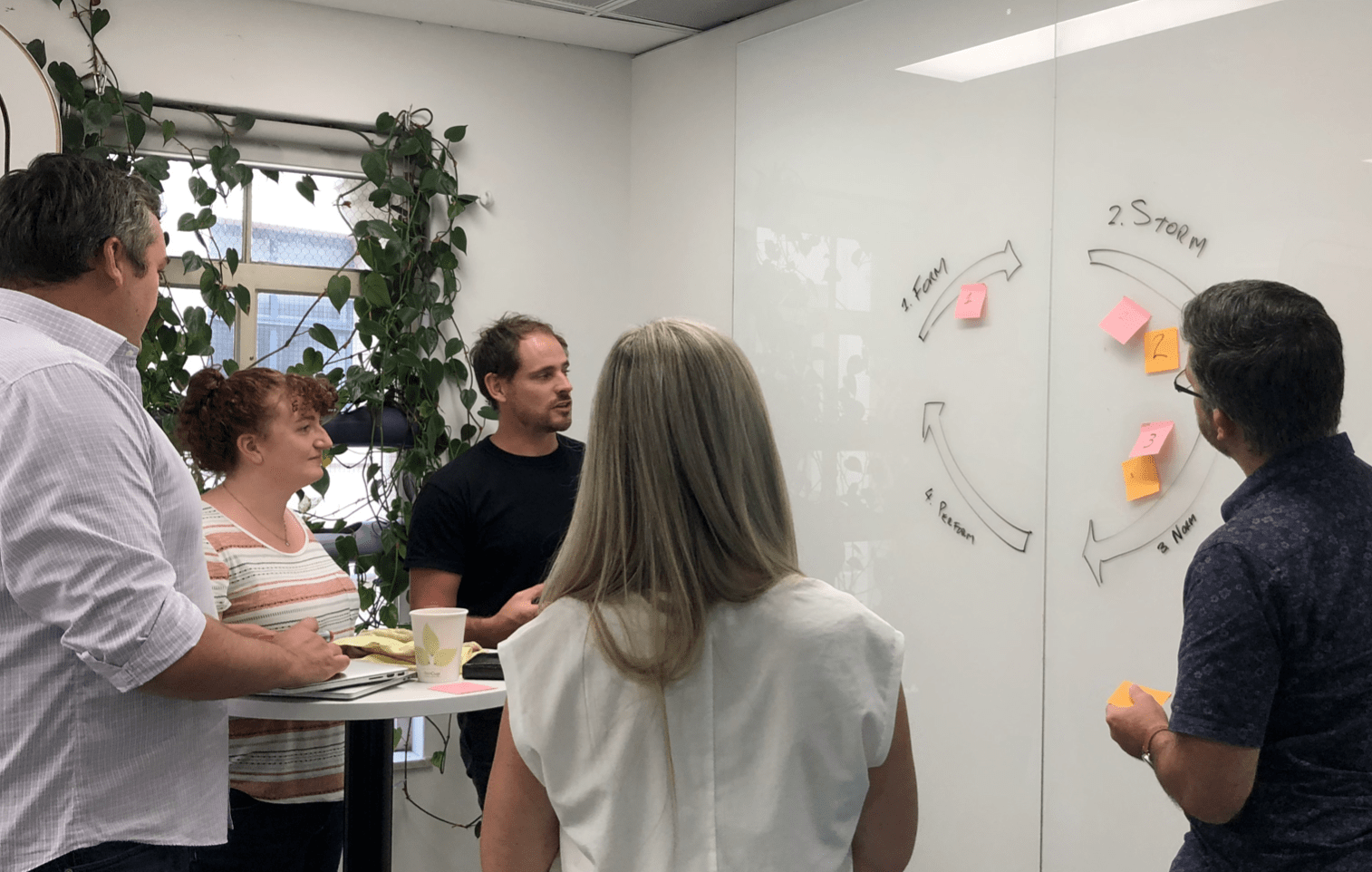5-Second summary
- American psychological researcher Bruce Tuckman developed the theory of Tuckman’s stages of group development in 1965.
- The theory includes four distinct phases: forming, storming, norming, and performing.
- The Atlassian Playbook contains exercises to help teams work through each phase to promote more harmonious teamwork.
Pop quiz. There are three teams: one is forming for the first time, another just added a new team member, and the third is re-aligning around priorities after the company announced a strategic pivot. Which team just entered a different stage of development? The answer is all three. Even subtle changes cause us to adjust the way we work. Team development is happening all the time – the question is whether you’re being intentional about it.
In the past, we would look to HR or our boss’ boss for guidance. While those people are still available when we need them, we usually don’t. Most teams today work according to the principles of the agile movement. Even if you’re not “Agile” (with a capital A), you self-organize around tasks. You don’t wait to be told how to do your job – you determine the best way to meet your objectives and get on with it.
Navigating the stages of team development in our agile world is no different. It should be self-organized and self-sustaining. Anyone can champion the cause: a manager, a scrum master, a program manager, or a team member keen to take on an informal leadership role.
Sounds great in theory, but putting it into practice can feel daunting. No worries. You got this. With a structured approach, you can improve your team’s performance at each stage of development.
What are the stages of team development?
The forming → storming → norming → performing model of group development was first proposed by psychological researcher Bruce Tuckman in 1965. His theory, known as “Tuckman’s stages of group development” stated that all of these phases are necessary and inevitable in order for a team to grow, face up to challenges, tackle problems, find solutions, plan work, and deliver results.

Notice how I’ve represented Tuckman’s model as a circle? That’s because team development is cyclical, not linear. Maybe your team is humming along in the “performing” stage, then a new person joins. Boom. You’ve got some “forming” to do. Likewise, a strategic pivot for the company sends your team back to the “storming” phase.
The team development cycle starts over more often than you might think. It doesn’t mean anything is wrong or that you’ve failed. It just means that when change happens, humans need time to adapt. Thankfully, we are highly adaptable creatures.
Navigating the “forming” stage
In this stage, your team is starting from scratch in one way or another. You’re coming together as a brand new team, or a new team member joins. In an agile context, the “forming” phase is a key part of the transition away from more traditional ways of working. You may not be reporting to a new manager, but you’re now part of a cross-functional project or product team. (In companies where agile is already the established way of working, pulling a cross-functional project team together is just business as usual.)
Feels like…
Everyone is excited. Curious. Maybe a bit nervous. There’s a new initiative to run at and you’re keen to get started. But there’s also confusion. You’re not sure who is doing what, or how to break this epic project into smaller components.
Job to be done
The team needs clarity and connection more than anything else at this stage. Don’t dive into execution mode too quickly. Take the time to call out assumptions about the work and (more importantly) how you’ll work together. Solving problems face-to-face instead of over email or chat is a good investment right now because you’ll get a richer sense of who your teammates are as people.
Tips and tactics
Pose lots of questions to your team, even if you think you know the answer. Take a cue from the Atlassian Team Playbook and make time for these three activities. Click the name of each activity below to get step-by-step instructions and other helpful resources like templates and videos.
- Icebreakers (5-15 min) – If you have a few minutes while people trickle into a meeting, then you’ve got time to start making the personal connections that help us do our best work together. Toss out just-for-fun questions like “What car did you learn to drive on?” Or, more purposeful questions like “What will the title of your autobiography be?” help teammates get to know each other and prime the brain for creative thinking. #TwoBirdsOneStone
- Elevator Pitch (30 min) – This exercise answers the “What exactly are we doing, and why?” question. Creating an elevator pitch together sets your team up with a consistent and simple explanation of your work and the unique value it delivers. It’s like MadLibs™ for the office.
- Goals, Signals, and Measures (90 min) – One of the best investments you can make at this stage is clarifying what you’re trying to achieve and how you’ll know you’re successful. This workshop involves brainstorming, discussion, and decision-making. It can be tough at times – I won’t lie – but the shared understanding you’ll build is worth powering through.
Navigating the “storming” stage
Recently, several teams in our engineering department undertook a massive, ludicrously complex, business-critical infrastructure project. The number of risks and dependencies sent these established and cohesive dev teams into a flurry of (ultimately, unproductive and/or counter-productive) activity. If your team has ever thrashed about like this, then you know what “storming” is.
Feels like…
Storming kind of stinks, to be honest. There’s a lot of confusion and frustration. Everything seems to be twice as hard as you’d expect.
Job to be done
The key to moving through this stage is to make things as simple as possible. Hopefully, your team’s purpose or desired outcome is understood by this point. Now it’s time to make sure everyone understands the incremental milestones on the way to your goal, and what their role is in helping the team get there. Clarity as to what success looks like at each milestone will give your team a much-needed confidence boost.
Tips and tactics
Focus on building a shared understanding across your team and with stakeholders. Here are three techniques I like to use.
- DACI (30-90 min) – The DACI framework helps you make group decisions efficiently and effectively. The secret is to clarify each person’s role. (Who is the decider? Who is contributing recommendations? Etc.) Create a default DACI that can apply to most decisions, then adjust as needed or create a custom DACI when the stakes are high or the situation is complicated.
- Roles and Responsibilities (60 min) – The name says it all. You’ll clarify each person’s role, what they’re responsible for, and any other expectations team members have of each other. Chances are, you’ll uncover some false assumptions as well – especially if your team had been cruising along in the “norming” or “performing” stage until recently.
- End-to-end Demo (30 min) – A visual representation of the final product or experience makes it easy for stakeholders to provide early feedback. Your “demo” might start as a diagram on a napkin. That’s fine. As you repeat this exercise over time, it’ll become higher fidelity and help your team see they’re making progress.
Navigating the “norming” stage
When you start to sense that the left hand knows what the right hand is doing, you’ve made it into the “norming” stage. The challenge now is to move a bit faster while keeping the quality of your work high.
Feels like…
Whereas storming is chaotic, norming feels reassuring. Your team is gaining momentum. An esprit de corps is emerging, and – dare I say? – a sense of pride.
Job to be done
The main thing is to keep that momentum high. Remove obstacles by coordinating tightly with adjacent and upstream teams. Validate your assumptions about what your customers need, then proactively decide what you’re not doing right now so you don’t get distracted. Backlog grooming for the win.
Tips and tactics
This is a time to recognize and improve your weak areas. Managers and project leads need to keep their eyes open, but be mostly hands-off so the team can build muscle around working independently.
- Trade-offs (30 min) – In this exercise, you’ll agree on what you should optimize for and where you can be flexible, so you can make those small, every-day decisions about your work autonomously. The trade-offs will be obvious. Cheap, perfect, and on time? Nope. You can have two of those, but not all three.
- Sparring (30-60 min) – Sparring is a way to get structured, constructive feedback from peers and stakeholders. Show them a work-in-progress, then ask them to critique it, challenge it, and suggest ways to make the next iteration better. Remember: to spar doesn’t mean to fight. It means to practice.
- Project Poster (three 60-min sessions) – Your poster is a living document that communicates the problem you’re tackling, why it’s worth solving, the research you’ve done, possible solutions, and any risks or assumptions. It’s a great way to keep the team and your stakeholders on the same page. I recommend building it out in three phases as you define the problem space, validate your assumptions, and get ready to execute.
Navigating the “performing” stage
At last! You’ve arrived! You and your teammates trust each other enough to get a little creative and innovative, while still delivering top-notch work on time. You’re kicking butt and taking names.
Feels like…
Awesomesauce.
Job to be done
Double down on building personal connections among teammates. When it’s time to celebrate meeting a milestone, consider indulging in a team dinner or day out doing something fun together. And, now that you’ve figured out established practices that help you collaborate effectively, share those with other teams.
Tips and tactics
You’ve got a good thing going now. Here are two ways to protect and augment it.
- Retrospective (30-60 min) – This classic agile technique works for any type of team in any industry. Gather up at the end of each iteration cycle (or, monthly) to reflect on what’s going well vs. what’s not, and agree on adjustments to make.
- Disruptive Brainstorming (60-90 min) – Oddly enough, introducing constraints when brainstorming leads to more creative ideas because your brain is forced out of its rut as you think your way around them. This technique is fast-paced and can be a lot of fun.
Which stage is your team in?
After reading everything above, you have a pretty good idea where your team is at – but does the rest of the team agree? We all perceive things in our own unique way based on past experience and what we know now. The stages of team development are no different.
None of us have perfect information, but we can get closer by sharing what we know and what we see. I like to play a game I call “Pin the Tail on the Tuckman” to uncover those differences in perception and align on where a team is at.

Draw a simple four-stage diagram and ask each person to place a dot or sticky note next to the stage they think the team is at. Then discuss and agree on next steps. Do you need to clarify roles and responsibilities? Work out a stakeholder communications plan? It’s a 10-minute investment that pays massive dividends.
Be intentional about teaming and you’ll go farther, faster. You’ve got permission. You’ve got the knowledge. The only thing you don’t have is an excuse.












































